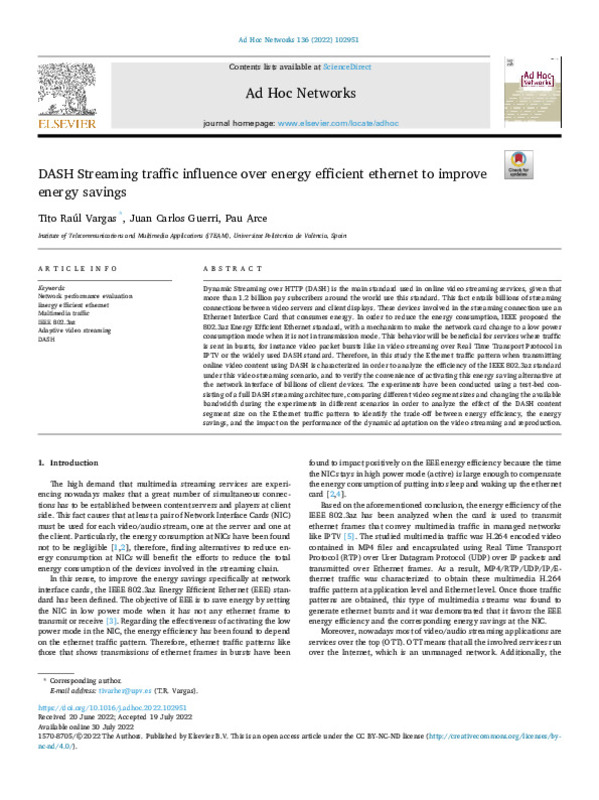JavaScript is disabled for your browser. Some features of this site may not work without it.
Buscar en RiuNet
Listar
Mi cuenta
Estadísticas
Ayuda RiuNet
Admin. UPV
DASH Streaming traffic influence over energy efficient ethernet to improve energy savings
Mostrar el registro sencillo del ítem
Ficheros en el ítem
| dc.contributor.author | Vargas, Tito Raúl
|
es_ES |
| dc.contributor.author | Guerri Cebollada, Juan Carlos
|
es_ES |
| dc.contributor.author | Arce Vila, Pau
|
es_ES |
| dc.date.accessioned | 2023-05-12T18:01:53Z | |
| dc.date.available | 2023-05-12T18:01:53Z | |
| dc.date.issued | 2022-11-01 | es_ES |
| dc.identifier.issn | 1570-8705 | es_ES |
| dc.identifier.uri | http://hdl.handle.net/10251/193316 | |
| dc.description.abstract | [EN] Dynamic Streaming over HTTP (DASH) is the main standard used in online video streaming services, given that more than 1.2 billion pay subscribers around the world use this standard. This fact entails billions of streaming connections between video servers and client displays. These devices involved in the streaming connection use an Ethernet Interface Card that consumes energy. In order to reduce the energy consumption, IEEE proposed the 802.3az Energy Efficient Ethernet standard, with a mechanism to make the network card change to a low power consumption mode when it is not in transmission mode. This behavior will be beneficial for services where traffic is sent in bursts, for instance video packet bursts like in video streaming over Real Time Transport Protocol in IPTV or the widely used DASH standard. Therefore, in this study the Ethernet traffic pattern when transmitting online video content using DASH is characterized in order to analyze the efficiency of the IEEE 802.3az standard under this video streaming scenario, and to verify the convenience of activating this energy saving alternative at the network interface of billions of client devices. The experiments have been conducted using a test-bed con- sisting of a full DASH streaming architecture, comparing different video segment sizes and changing the available bandwidth during the experiments in different scenarios in order to analyze the effect of the DASH content segment size on the Ethernet traffic pattern to identify the trade-off between energy efficiency, the energy savings, and the impact on the performance of the dynamic adaptation on the video streaming and reproduction. | es_ES |
| dc.language | Inglés | es_ES |
| dc.publisher | Elsevier | es_ES |
| dc.relation.ispartof | Ad Hoc Networks | es_ES |
| dc.rights | Reconocimiento - No comercial - Sin obra derivada (by-nc-nd) | es_ES |
| dc.subject | Network performance evaluation | es_ES |
| dc.subject | Energy efficient ethernet | es_ES |
| dc.subject | Multimedia traffic | es_ES |
| dc.subject | IEEE 802.3az | es_ES |
| dc.subject | Adaptive video streaming DASH | es_ES |
| dc.subject.classification | INGENIERÍA TELEMÁTICA | es_ES |
| dc.title | DASH Streaming traffic influence over energy efficient ethernet to improve energy savings | es_ES |
| dc.type | Artículo | es_ES |
| dc.identifier.doi | 10.1016/j.adhoc.2022.102951 | es_ES |
| dc.rights.accessRights | Abierto | es_ES |
| dc.contributor.affiliation | Universitat Politècnica de València. Instituto Universitario de Telecomunicación y Aplicaciones Multimedia - Institut Universitari de Telecomunicacions i Aplicacions Multimèdia | es_ES |
| dc.contributor.affiliation | Universitat Politècnica de València. Escuela Técnica Superior de Ingenieros de Telecomunicación - Escola Tècnica Superior d'Enginyers de Telecomunicació | es_ES |
| dc.description.bibliographicCitation | Vargas, TR.; Guerri Cebollada, JC.; Arce Vila, P. (2022). DASH Streaming traffic influence over energy efficient ethernet to improve energy savings. Ad Hoc Networks. 136:1-10. https://doi.org/10.1016/j.adhoc.2022.102951 | es_ES |
| dc.description.accrualMethod | S | es_ES |
| dc.relation.publisherversion | https://doi.org/10.1016/j.adhoc.2022.102951 | es_ES |
| dc.description.upvformatpinicio | 1 | es_ES |
| dc.description.upvformatpfin | 10 | es_ES |
| dc.type.version | info:eu-repo/semantics/publishedVersion | es_ES |
| dc.description.volume | 136 | es_ES |
| dc.relation.pasarela | S\473323 | es_ES |
| dc.contributor.funder | Universitat Politècnica de València |








